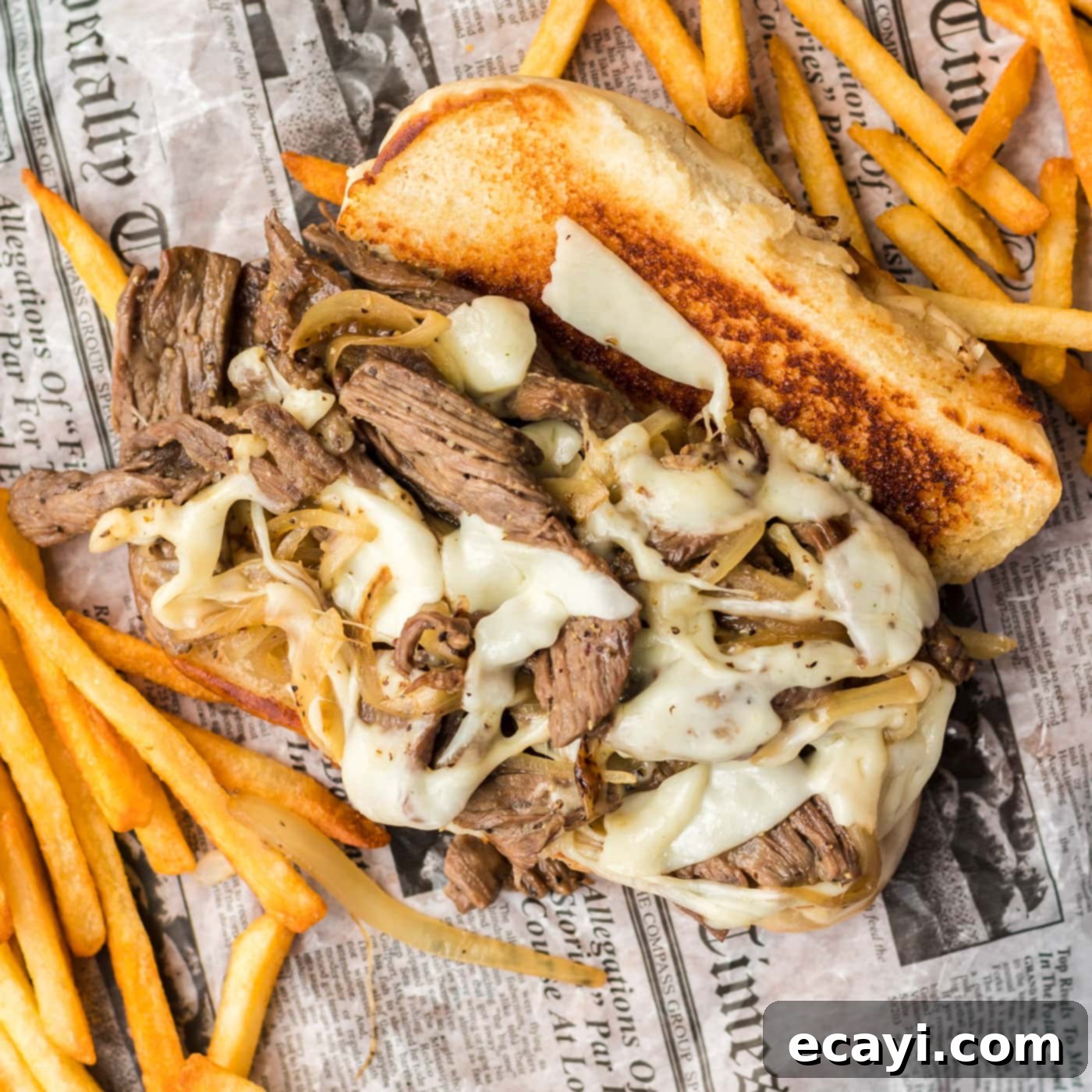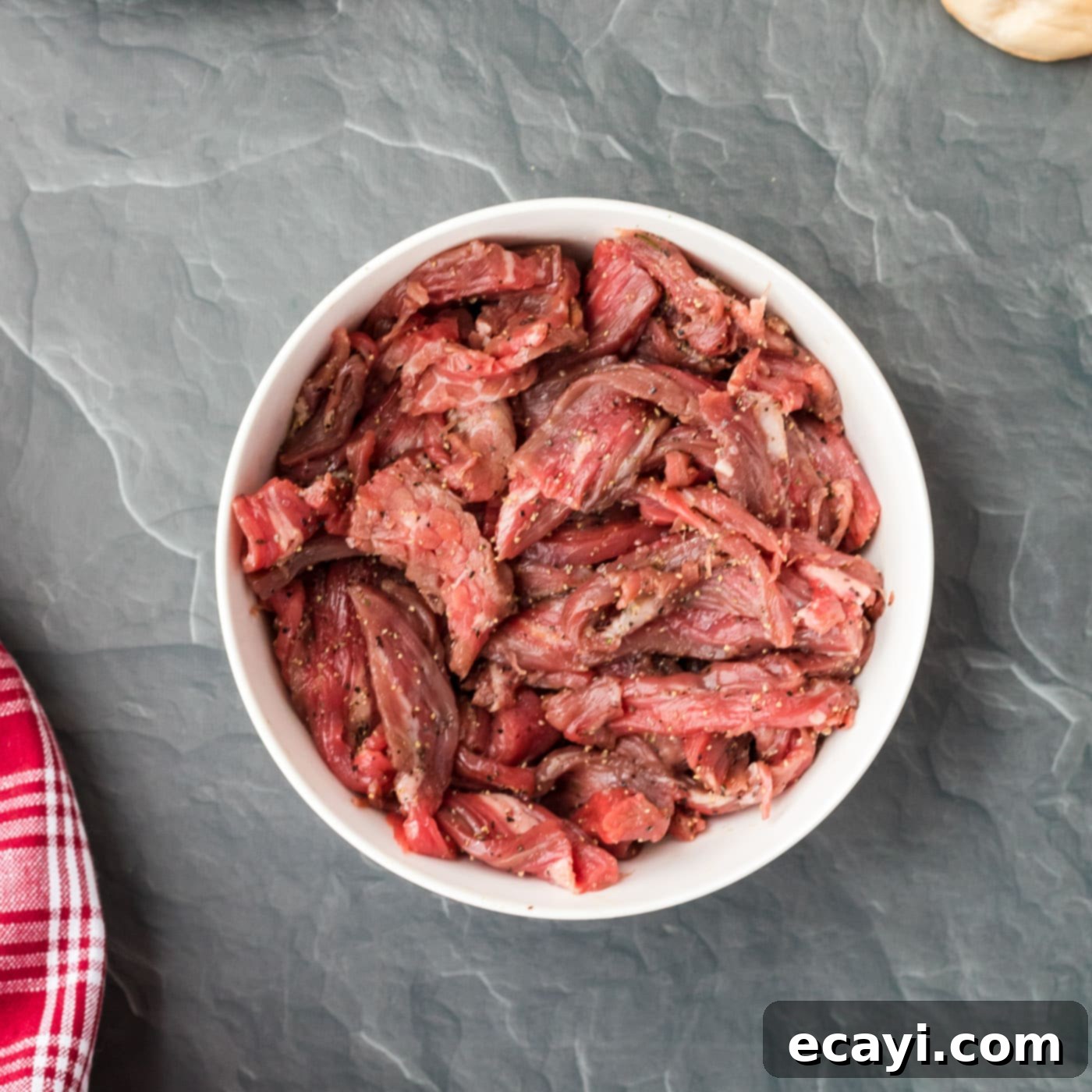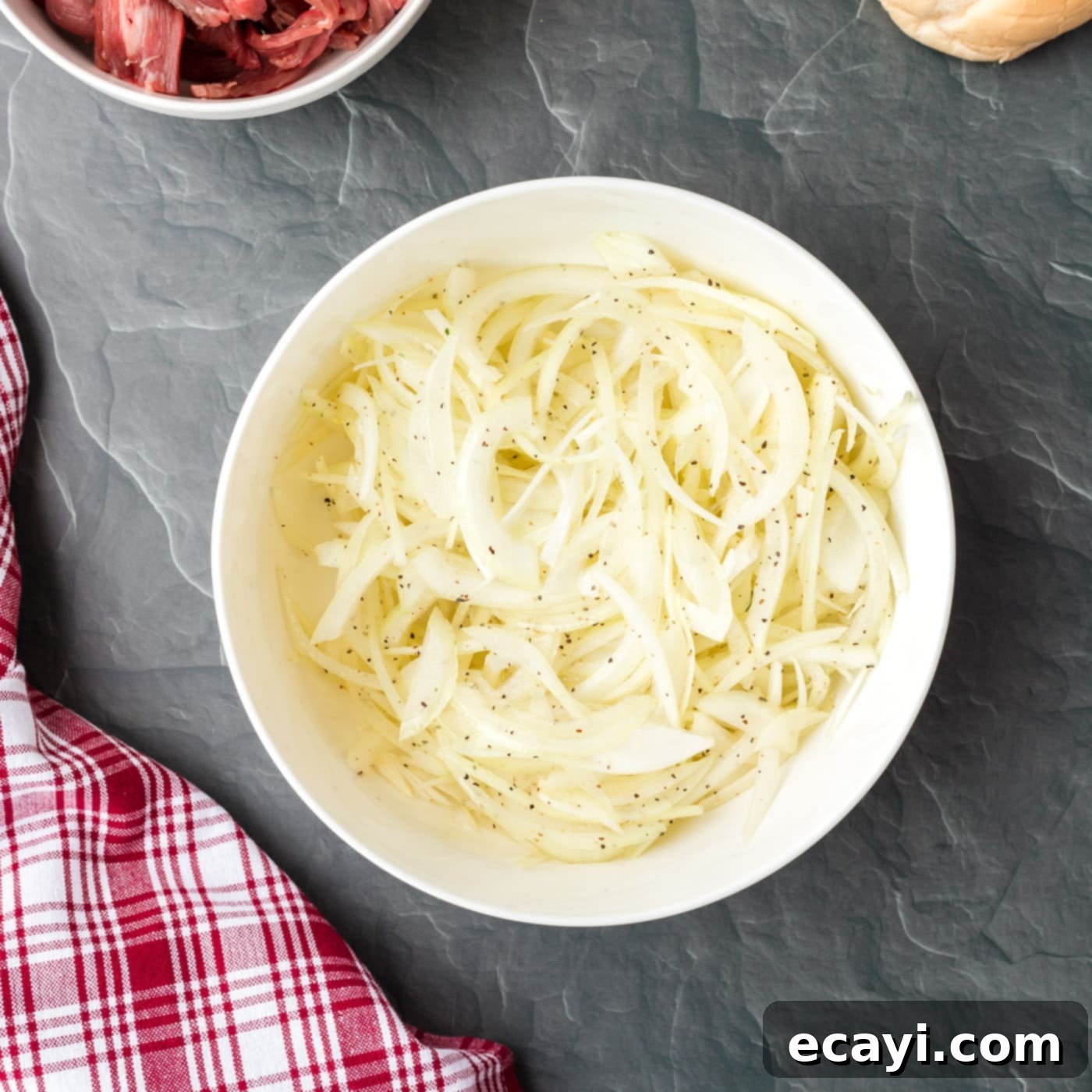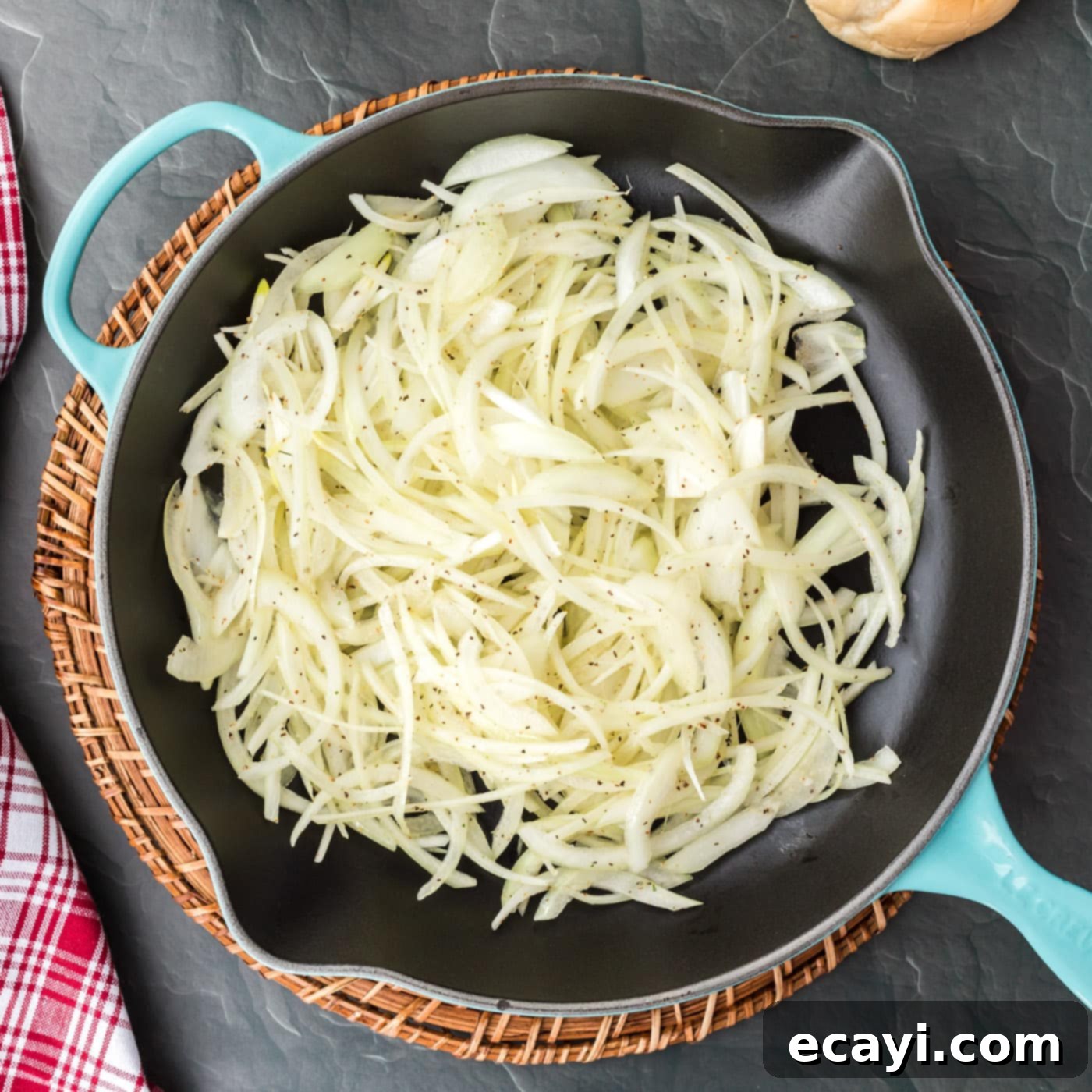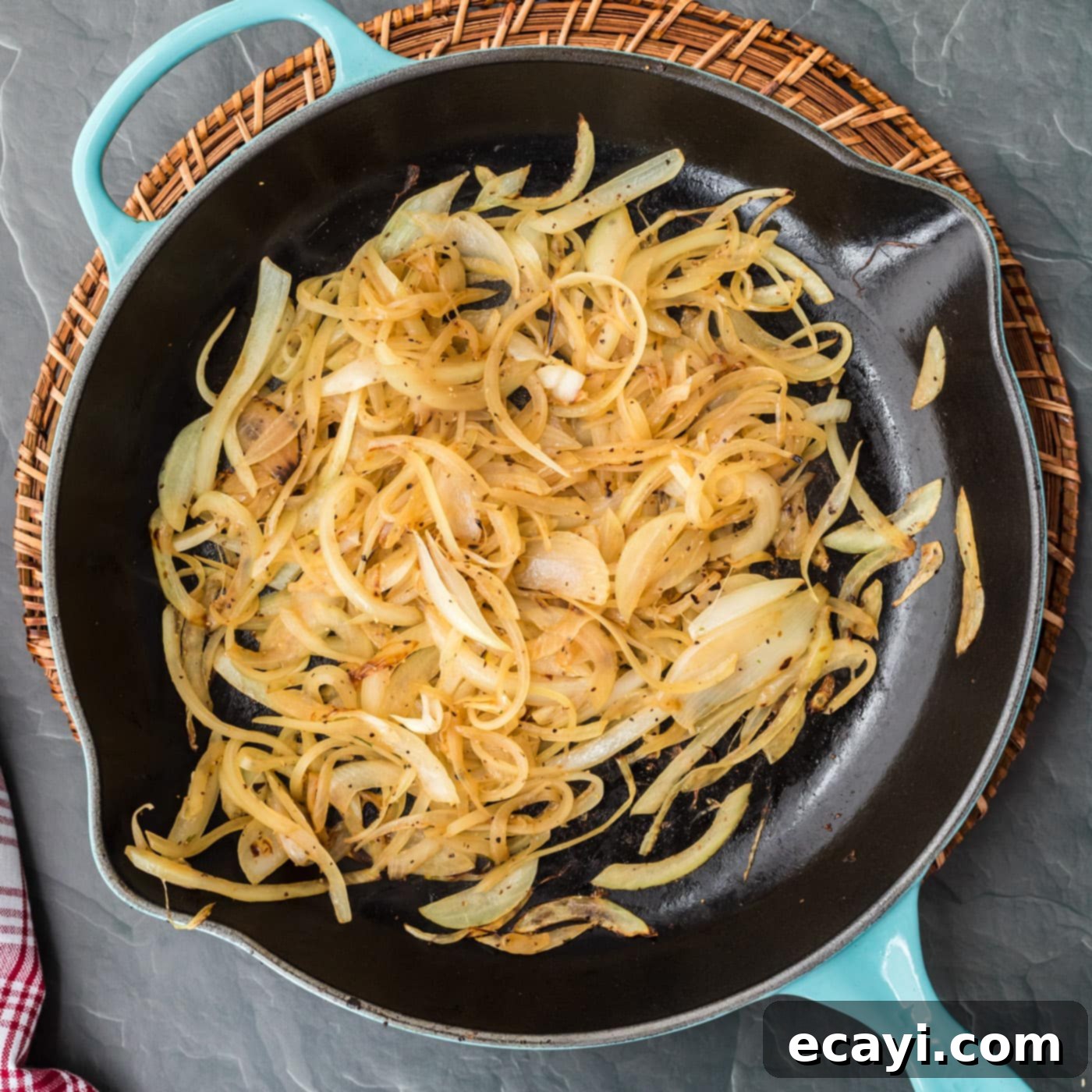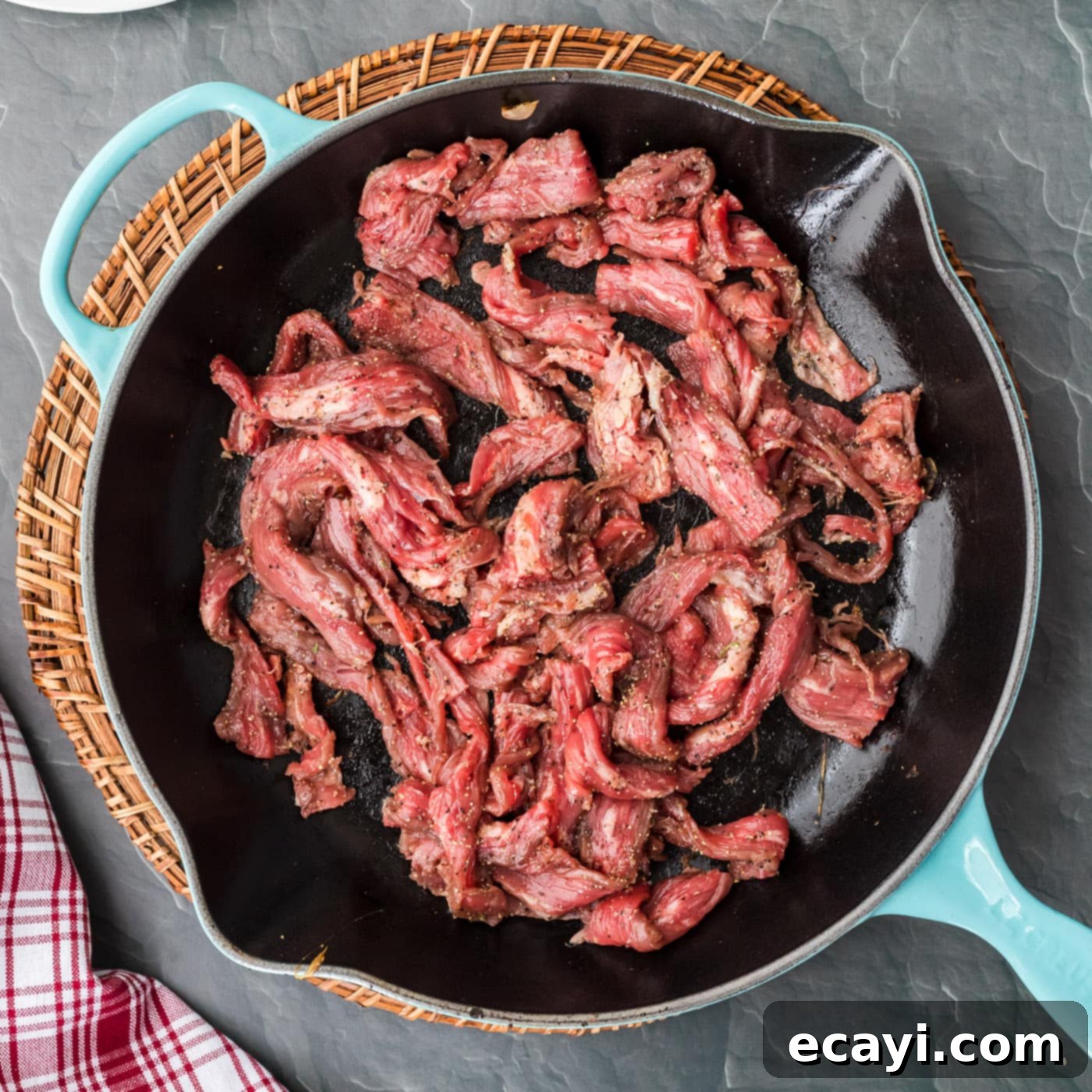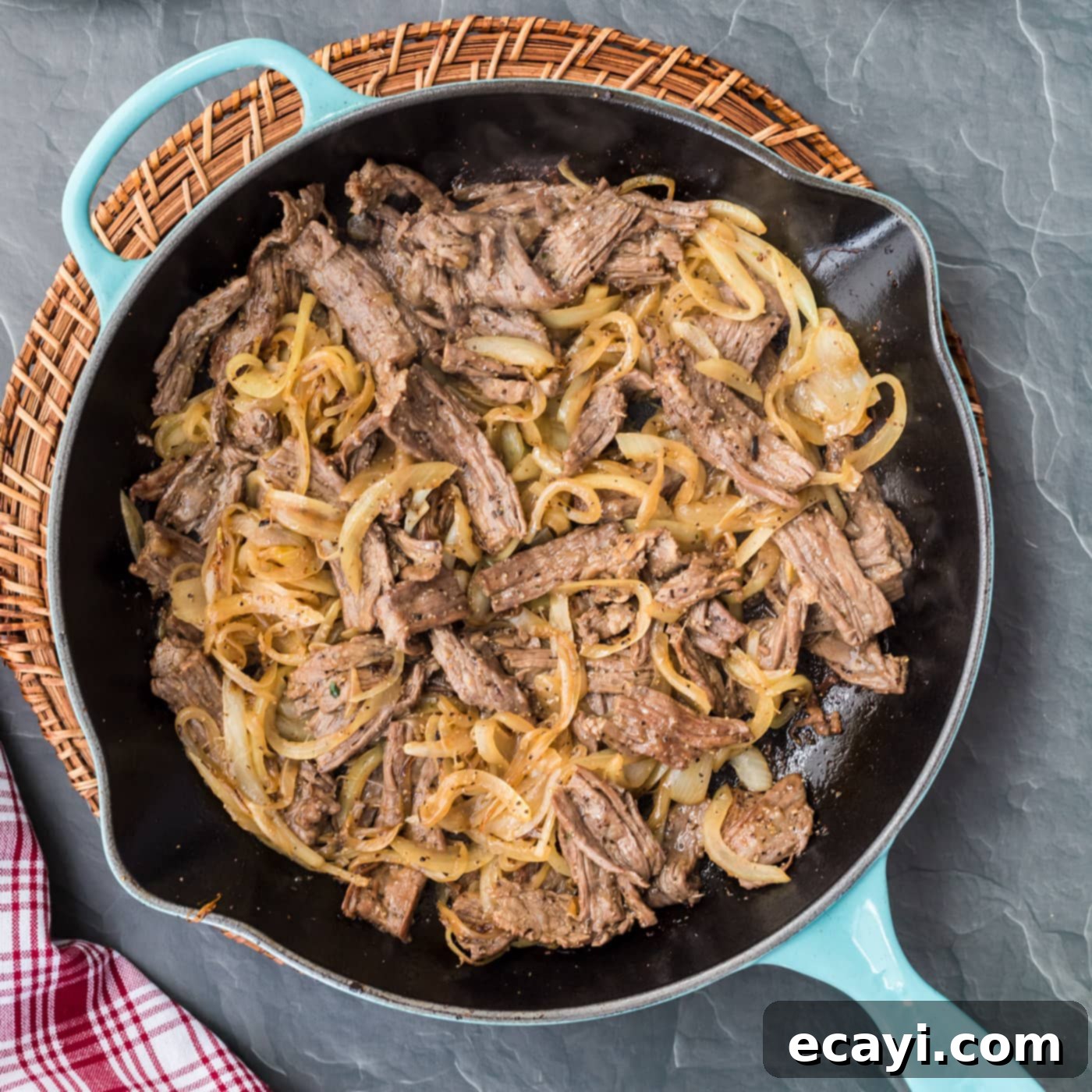Authentic Philly Cheesesteak Recipe: Sliced Steak, Caramelized Onions & Melted Provolone
There are few sandwiches as iconic and universally loved as the Philly Cheesesteak. Originating from the bustling streets of Philadelphia, this culinary masterpiece is more than just a meal; it’s a cultural staple. Our carefully crafted Philly cheesesteak recipe brings you the quintessential experience, featuring thinly sliced, perfectly seasoned steak, sweet and savory caramelized onions, and wonderfully melty provolone cheese, all nestled within a perfectly toasted hoagie bun. Every bite offers a harmonious blend of textures and robust flavors that will transport you straight to the heart of Pennsylvania.
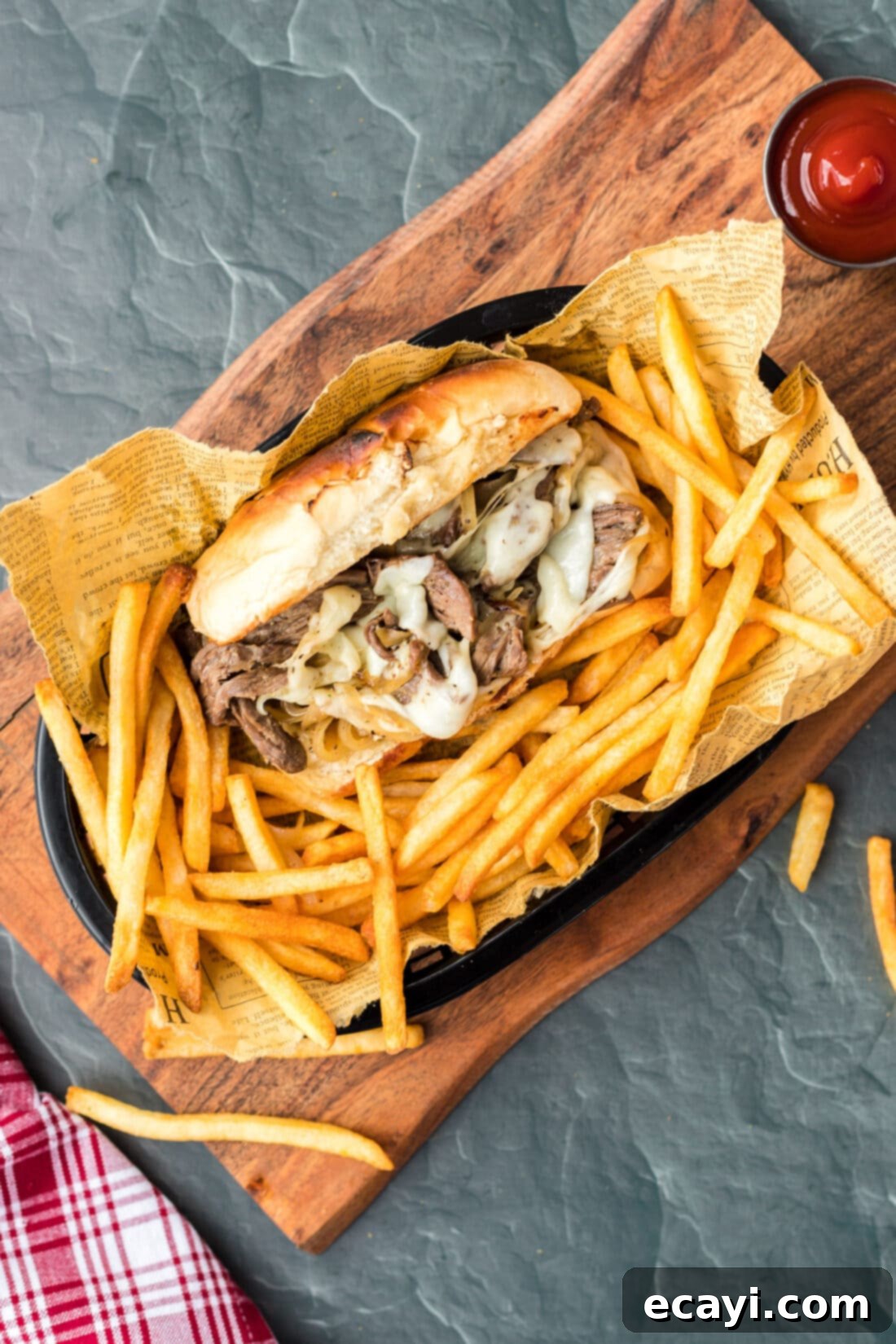
Why This Homemade Philly Cheesesteak Recipe is a Must-Try
The Philly cheesesteak is an East Coast legend, a sandwich that evokes passionate debates among food enthusiasts, much like its regional cousin, the lobster roll. Depending on where you stand, or rather, where you’re from, opinions vary sharply on what constitutes the “perfect” cheesesteak. The true classic form, often found in the most esteemed establishments in Philadelphia, traditionally features thinly sliced steak, sautéed onions, and, controversially for some, Cheez Whiz. However, our recipe embraces the equally popular and widely adored provolone cheese, which lends a mild, slightly tangy creaminess that beautifully complements the rich beef and tender onions.
Regardless of your preferred cheese or additions, we believe you’ll agree that the fundamental pleasure of a Philly cheesesteak lies in its savory bite. The tender, juicy beef, the luscious melt of cheese, and the sweet sharpness of the onions combine in a symphony of flavors that simply works, no matter the specific ingredients used. This sandwich holds such a special place in our hearts that we’ve even transformed its incredible flavors into an irresistible Philly Cheesesteak Dip, perfect for sharing. We encourage you to have fun with this recipe; while there are traditions, there are truly no strict rules when it comes to customizing your enjoyment. Experiment, adapt, and make it your own – the delicious outcome is guaranteed.
Our recipe stands out because it balances authenticity with home-cook accessibility. We focus on techniques that guarantee maximum flavor and the perfect texture: from properly slicing the steak to achieving beautifully caramelized onions, and ensuring your cheese melts into a gooey blanket. We provide clear, step-by-step instructions that demystify the process, allowing anyone to create a restaurant-quality cheesesteak in their own kitchen. The simplicity of the core ingredients, combined with our expert tips, ensures that even a novice cook can achieve a mouth-watering result. This isn’t just a recipe; it’s your guide to mastering a beloved American classic.
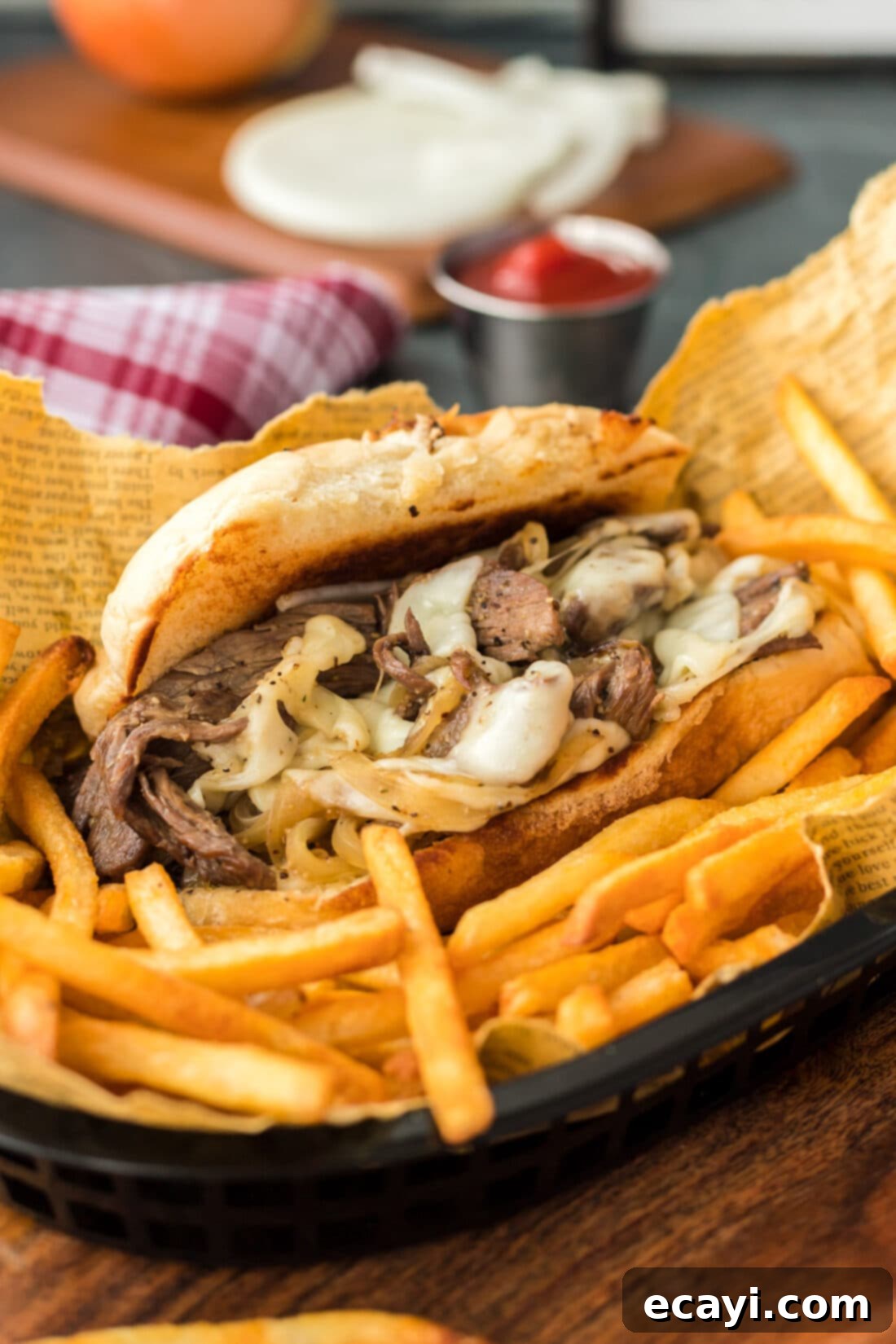
Essential Ingredients for Your Perfect Philly Cheesesteak
Crafting a truly memorable Philly cheesesteak relies on a few key, high-quality ingredients. While the concept is simple, the selection and preparation of each component make all the difference. You’ll find a complete list of all measurements, ingredients, and detailed instructions in the printable recipe card located at the end of this post.
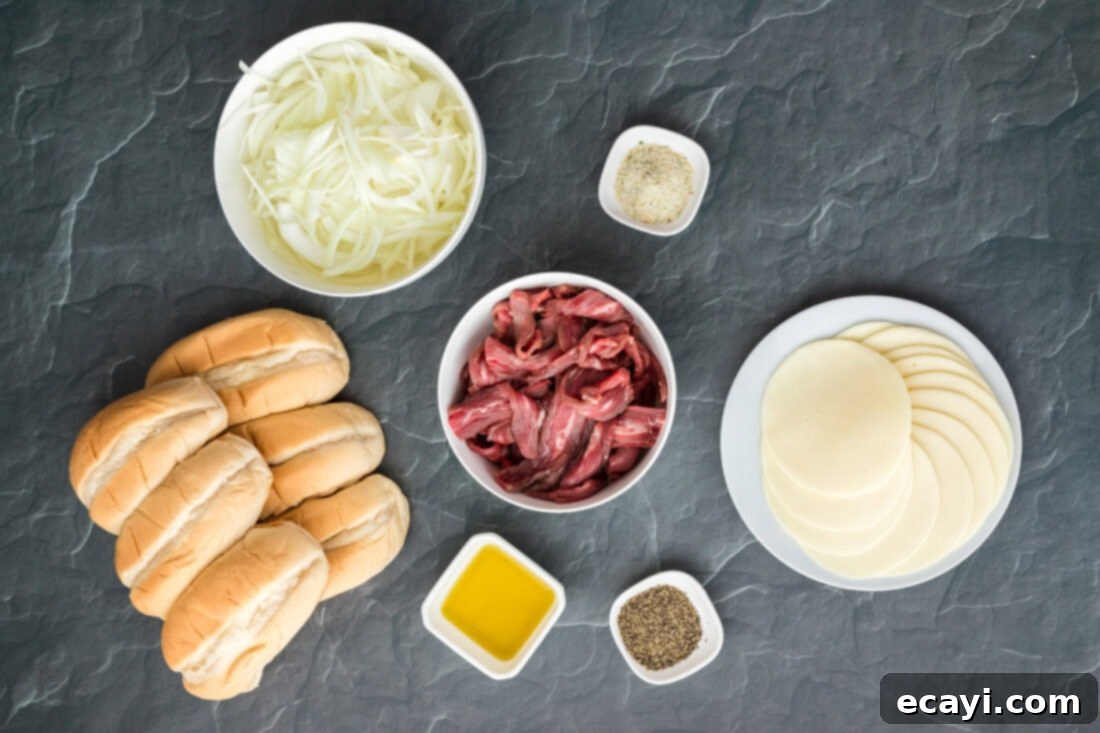
Ingredient Spotlight & Smart Substitutions
Understanding each ingredient and its role is key to mastering this iconic sandwich. Here’s a closer look, along with helpful substitution suggestions to tailor the recipe to your preferences or what you have on hand.
STEAK – For an incredibly tender and authentic Philly cheesesteak, flank steak is an excellent choice. Its lean profile and robust flavor make it ideal for this preparation. Alternatively, thinly sliced ribeye is a popular premium option, known for its marbling and rich taste. Top round or sirloin also work beautifully, offering a great balance of flavor and tenderness when sliced correctly. The secret to achieving those paper-thin slices, characteristic of a true cheesesteak, is to partially freeze the meat for about 20-30 minutes before slicing. This firms it up, making it much easier to cut against the grain into uniform, delicate strips. Always remember to bring the sliced meat back to room temperature before cooking to ensure even and quick cooking.
CHEESE – Our preferred choice for this cheesesteak is provolone, which melts beautifully and contributes a mild, slightly sharp flavor that doesn’t overpower the steak and onions. However, the world of cheesesteaks is vast and varied when it comes to cheese. Many purists and enthusiasts swear by American cheese for its supreme meltability and creamy texture, or the iconic Cheez Whiz for its distinctively tangy, velvety blanket. For those who enjoy a different flavor profile, mozzarella can offer a milder, stringier melt, while white cheddar could provide a sharper, more complex note. Don’t hesitate to experiment with your favorite melting cheese!
BREAD – The bread is just as crucial as the filling. A sturdy yet soft hoagie bun is paramount, providing the perfect vessel to hold the generous, juicy fillings without becoming soggy. Look for fresh, high-quality hoagie rolls that have a slight chew to the crust and a soft interior. If hoagie buns are hard to find, a good loaf of Italian bread, cut into appropriate lengths, can serve as a fantastic alternative. The key is a bread that can absorb some of the savory juices while maintaining its structural integrity, offering that satisfying bite with every mouthful. Lightly toasting the buns adds another layer of texture and prevents them from getting too soft too quickly.
ONIONS – A large yellow onion, julienned, is our go-to for its balanced sweetness when cooked. Caramelized onions are non-negotiable for that authentic Philly flavor. The slow cooking process transforms their sharp pungency into a deep, sweet, and umami-rich component that beautifully complements the beef and cheese. Ensure they are cooked until soft, deeply golden, and fragrant, not just translucent. You can also mix in some red onion for a slightly different flavor profile if you wish, or add other vegetables like bell peppers, which we discuss in the FAQ section.
OLIVE OIL & SEASONING – A good quality olive oil helps in sautéing the ingredients, contributing a subtle richness. Simple seasonings like garlic salt and black pepper are all you need. The quality of the meat and the sweetness of the onions are the stars, and these seasonings enhance rather than overshadow their natural flavors. You can adjust the amount of garlic salt and black pepper to your personal taste, or even add a dash of onion powder for an extra layer of savory depth.
How to Assemble Your Irresistible Philly Cheesesteak
These step-by-step photos and detailed instructions are designed to help you visualize each stage of making this incredibly satisfying recipe. For the complete printable version, including precise measurements and instructions, simply Jump to Recipe at the very bottom of this post.
- Begin by preparing your steak. Slice the flank steak against the grain into very thin strips. This is crucial for tenderness. Once sliced, place the meat in a bowl and toss it thoroughly with half of the olive oil to ensure each piece is lightly coated. Season generously with half of the garlic salt and half of the black pepper, mixing well so the seasonings are evenly distributed.

- Next, prepare your onions. Take the julienned yellow onion and place it in a separate bowl. Drizzle with the remaining olive oil and season with the remaining garlic salt and black pepper. Toss until the onions are well coated. This ensures they cook evenly and caramelize beautifully.

- Heat a large, heavy-bottomed skillet or griddle over medium-high heat. Allow it to get nice and hot before adding any ingredients. A hot pan is essential for proper searing and caramelization.
- Add the seasoned onions to the hot skillet. Sauté them, stirring occasionally, until they become beautifully tender and develop a rich, golden caramelization. This process typically takes about 8-10 minutes, bringing out their natural sweetness. Once cooked to your desired tenderness and color, remove the onions from the skillet and set them aside on a plate. Maintain the skillet’s heat.


- Add the seasoned steak strips to the hot skillet, spreading them out in a single layer as much as possible. Cook the meat rapidly until it’s partially cooked, with some pink still visible in the center. This usually takes about 2-3 minutes, ensuring the steak remains tender and doesn’t overcook.

- Once the steak is partially cooked, push it to one side of the skillet, creating an empty space. Add the reserved caramelized onions back into the empty side of the skillet.
- Now, combine the onions and meat together in the skillet. Continue to cook for another 5-7 minutes, stirring occasionally, until the meat is thoroughly cooked through and the onions are fully integrated with the steak, creating a cohesive, flavorful mixture.

- Reduce the heat in the skillet to its lowest setting. This is important for melting the cheese without burning the meat.
- Arrange the provolone cheese strips evenly over the top of the meat and onion mixture. Cover the pan with a lid (or foil) and allow the cheese to melt slowly and gloriously over the hot filling, becoming wonderfully gooey and irresistible. This usually takes 1-2 minutes.
- While the cheese is melting, you can lightly toast your hoagie buns if desired. This adds a lovely crunch and warmth. Once the cheese is perfectly melted, use a sturdy spatula to scoop generous portions of the cheese-covered steak and onion mixture directly into the prepared hoagie buns. Serve immediately and enjoy your homemade, authentic Philly Cheesesteak!
Frequently Asked Questions & Expert Tips for the Best Philly Cheesesteak
Yes, absolutely! While traditional Philly cheesesteaks often stick to just steak and onions, the beauty of this sandwich is its adaptability. Many regions and personal preferences welcome additional ingredients. Feel free to add thinly sliced bell peppers (green, red, or yellow), banana peppers for a tangy kick, or even hot peppers if you crave some heat. For mushrooms, slice them and toss them in the skillet while you sauté the onions. They will cook down beautifully and add an earthy depth to your sandwich. Just ensure they are cooked until tender before combining with the steak.
We recommend using olive oil for its flavor and medium-high smoke point, which is suitable for sautéing the steak and onions. However, vegetable oil, canola oil, or even a blend of butter and oil can also be used. The goal is to provide enough fat to brown the meat and caramelize the onions without burning, so choose an oil that can withstand the heat.
Beyond slicing against the grain and partially freezing for thin cuts, avoid overcrowding the pan when cooking the steak. Cooking in batches if necessary ensures a good sear and prevents the meat from steaming, which can lead to toughness. Also, cook it quickly over medium-high heat until just done; overcooking will dry out the steak and make it chewy.
You can certainly prep some ingredients in advance. Slice the steak and store it in an airtight container in the refrigerator for up to 24 hours. You can also julienne and season the onions ahead of time. However, for the best flavor and texture, we recommend cooking the steak and onions fresh right before serving. The cheese should always be melted just before assembly.
Reheating a cheesesteak can be tricky to maintain its quality. The best method is to gently warm it in a skillet over low to medium heat, covered, until the meat is heated through and the cheese re-melts. You can also use an air fryer for a crispy bun. Avoid the microwave if possible, as it can make the bread soggy and the meat rubbery.
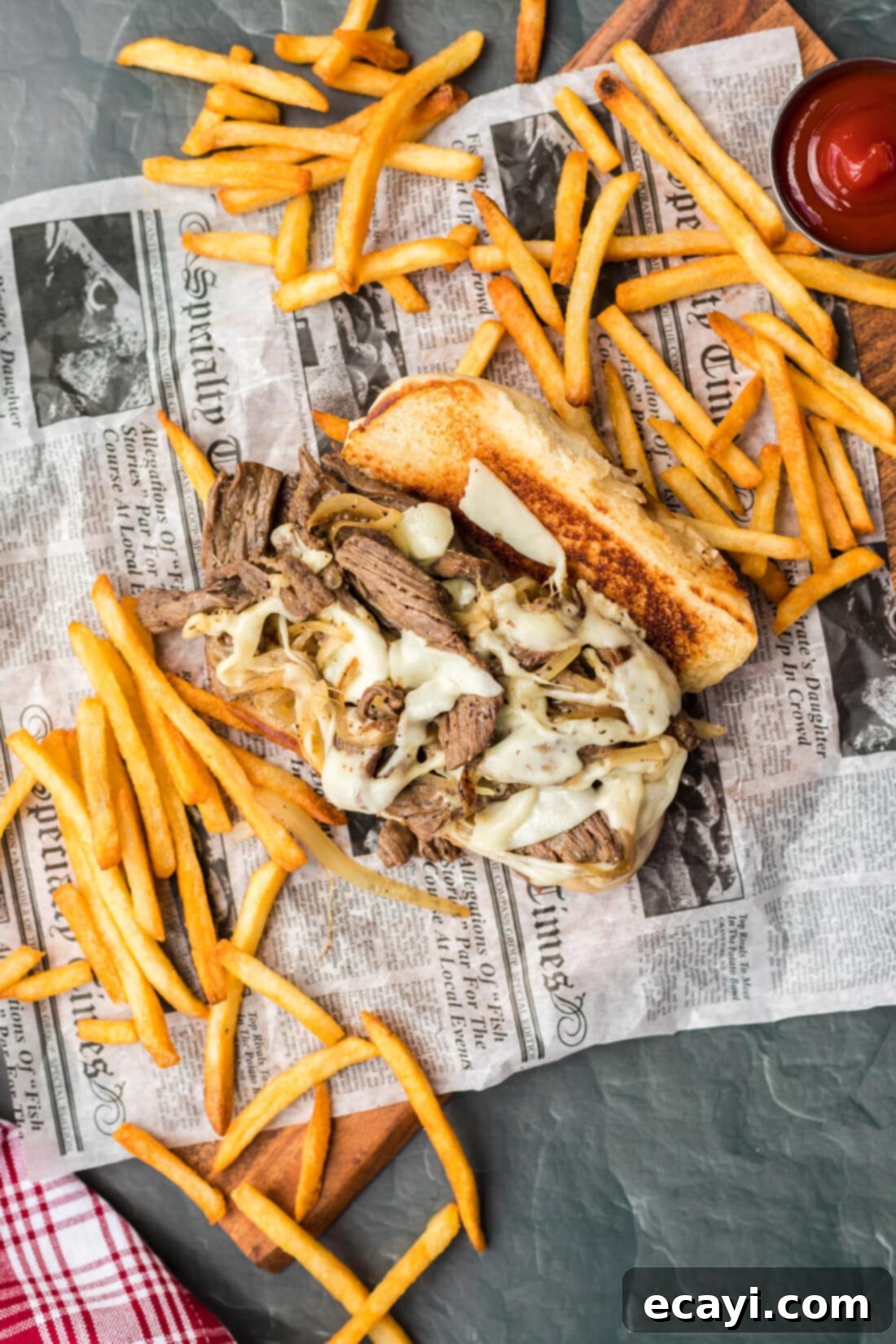
Delectable Serving Suggestions
A classic Philly cheesesteak is a meal in itself, but pairing it with the right side dishes can elevate the experience even further. Serve your hot and melty cheesesteak with crispy french fries, crunchy potato chips, golden onion rings, savory sweet potato fries, or a refreshing side of coleslaw to cut through the richness. For an extra kick of flavor, a dash of your favorite hot sauce on top of the filling can add a welcome zest. Beyond the traditional toppings like peppers and mushrooms (which you can certainly toss in with the onions), consider adding a dollop of mayonnaise, a squirt of ketchup, or even some pickled cherry peppers for an authentic Philly deli vibe. For an ultimate indulgence, lightly toast your hoagie rolls with a thin layer of butter before piling on the beefy, cheesy mixture. Pair it with an ice-cold soda or a local craft beer for a truly satisfying meal. Enjoy this hearty and flavorful sandwich, customized exactly to your liking!
Explore More Mouth-Watering Sandwich Recipes
If you love a good sandwich as much as we do, you’ll definitely want to explore these other fantastic recipes. From seafood delights to hearty meat fillings, there’s a sandwich for every craving:
- Shrimp Po Boy: A classic New Orleans sandwich loaded with crispy fried shrimp.
- Reuben Sandwich: A savory stack of corned beef, Swiss cheese, sauerkraut, and Russian dressing.
- Corned Beef Sandwich: Simple, hearty, and packed with tender corned beef.
- Pork Tenderloin Sandwich: Crispy, pounded pork tenderloin, a Midwestern favorite.
- Air Fryer Italian Sausage and Peppers: A lighter take on a classic, perfect for a quick and flavorful meal.
- Sausage and Peppers: A timeless combination of savory sausage and sweet bell peppers.
- Cuban Sandwich: A pressed delight featuring ham, roast pork, Swiss cheese, pickles, and mustard.
I absolutely adore cooking and baking, and I love sharing my culinary adventures and kitchen wisdom with all of you! Remembering to visit the blog daily for new recipes can be a challenge, which is why I offer a convenient newsletter delivered straight to your inbox every time a new recipe is posted. Simply subscribe today and start receiving your free daily recipes, making sure you never miss out on a delicious creation!
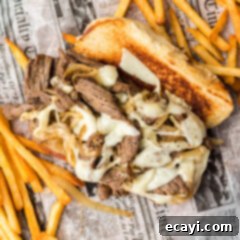
Philly Cheesesteak
IMPORTANT – There are often Frequently Asked Questions within the blog post that you may find helpful. Simply scroll back up to read them!
Print It
Pin It
Rate It
Save ItSaved!
Ingredients
- 1 pound flank steak
- 2 teaspoons garlic salt divided
- 2 teaspoons black pepper divided
- 1 large yellow onion julienned
- 2 Tablespoons olive oil divided
- 6 slices provolone cheese sliced into strips
- 3 hoagie buns
Things You’ll Need
-
Large skillet with lid
-
Tongs
-
Spatula
Before You Begin
- For easier and thinner slicing, partially freeze the flank steak for about 20-30 minutes before cutting against the grain. Ensure the meat returns to room temperature before cooking to ensure even results.
- Flank steak is renowned for its tenderness and is an excellent choice for Philly cheesesteak. Other fantastic alternatives include thinly sliced ribeye, top round, or sirloin, each offering a slightly different texture and flavor profile.
- While provolone is our cheese of choice for its delightful melt and mild tang, many prefer the classic American cheese for its supreme creaminess or Cheez Whiz for its iconic Philadelphia taste. Feel free to use your favorite!
- We recommend using fresh hoagie buns for their perfect texture and ability to hold the generous filling. A good quality Italian bread loaf can also be used as a delicious substitute.
Instructions
-
Carefully slice the flank steak very thin, cutting against the grain to ensure maximum tenderness. In a medium bowl, toss the sliced meat with half of the olive oil, ensuring each strip is lightly coated. Season evenly with half of the garlic salt and half of the black pepper.
-
In a separate bowl, toss the julienned yellow onions with the remaining olive oil. Season these onions with the remaining garlic salt and black pepper, mixing until well coated.
-
Heat a large, heavy-bottomed skillet or griddle over medium-high heat until it is thoroughly hot.
-
Add the seasoned onions to the hot skillet. Cook, stirring occasionally, until they become soft, deeply golden, and beautifully caramelized, typically taking 8-10 minutes. Once cooked, remove the onions from the skillet and set them aside.
-
Increase the skillet heat slightly if needed. Add the seasoned meat to the skillet, spreading it out. Cook for about 2-3 minutes, stirring occasionally, until the steak is partially cooked but still shows a hint of pink. Avoid overcooking to maintain tenderness.
-
Push the cooked meat to one side of the skillet, creating an empty space. Return the caramelized onions to the empty side of the skillet.
-
Toss the onions and meat together thoroughly in the skillet. Continue cooking for another 5-7 minutes, ensuring the meat is fully cooked and the flavors are well combined.
-
Reduce the heat to the lowest setting. This slow heat is crucial for perfectly melting the cheese.
-
Arrange the provolone cheese slices directly over the meat and onion mixture. Cover the pan with a lid (or aluminum foil) and allow the cheese to melt completely, becoming deliciously gooey and bubbling, typically within 1-2 minutes.
-
If desired, lightly toast your hoagie buns until warm and slightly crisp. Using a sturdy spatula, carefully transfer generous portions of the hot, cheese-covered meat and onion mixture onto the prepared hoagie buns. Serve immediately and savor your homemade Philly Cheesesteak!
Nutrition
The recipes on this blog are meticulously tested using a conventional gas oven and a gas stovetop. Please be aware that cooking and baking results can vary, especially with older ovens, which may heat inconsistently. Utilizing an inexpensive oven thermometer can help ensure your oven is consistently reaching the correct temperature. If you opt for a toaster oven or countertop oven, keep in mind that their heat distribution might differ from a full-sized conventional oven, potentially requiring adjustments to your cooking or baking times. For recipes involving appliances like pressure cookers, air fryers, or slow cookers, direct links to the specific models we use are provided within each respective recipe. In the case of baking recipes where measurements are given by weight, please note that using volume measurements (cups) instead may lead to different results, and we cannot guarantee success with that method.
